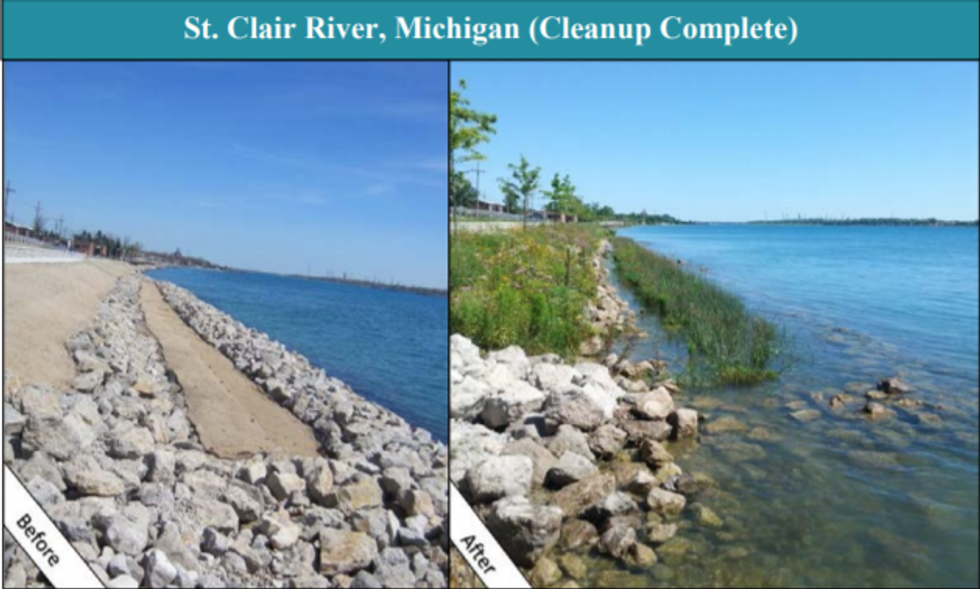
© 2024 Blaze Media LLC. All rights reserved.
Can a tree grow in the forest if the federal government isn’t around to fund it?
March 29, 2019
According to the Detroit News, on his way to the rally in Grand Rapids Thursday night, President Trump spoke with Michigan Republicans and decided not to cut the Great Lakes Restoration Initiative (GLRI) from $300 million to $30 million in the upcoming budget.
Trump was met at the Gerald R. Ford International Airport in Grand Rapids by Republican U.S. Reps. Bill Huizenga of Zeeland, John Moolenaar of Midland and Jack Bergman of Watersmeet, state Rep. Matt Hall and former Michigan Attorney General Bill Schuette.After a discussion with the congressional Republicans en route to the rally, Trump announced he would abandon a budget proposal to slash funding 90 percent for the Great Lakes Restoration Initiative, a plan criticized by Michigan Republicans and Democrats alike. The initiative will be fully financed at $300 million, he said, as it has in recent budgets after Congress restored the funding.
“I support the Great Lakes,” Trump said. “They’re beautiful. They’re big, very deep. Record deepness, right?”
I’m not sure about record deepness, but I am sure that throwing money down the drain every year to try to erase human “interference” with nature is record stupidity.
First of all, the Great Lakes are indeed important. But it really doesn’t take much poking around the over 3,500 projects the GLRI is responsible for to see how ridiculous some of these projects are and, in some cases, how doing nothing would produce the same result.
The GLRI is popular with politicians because it signals that they care about the environment. It is popular with voters because they believe the effort is doing something to save the environment, a cause we have all been conditioned to fight for. But we’ve spent over $2 billion on programs like wild rice restoration in Allouez Bay, Wisconsin. Why, you ask? Here is what the University of Wisconsin-Superior noted:
Historically, wild rice provided an important food and cultural component for Native American tribes including the Ojibwa, Menomonee, and Dakota. Early Wisconsin explorers described abundant wild rice beds that hindered their travel on many waterways. Wild rice is also a source of nutrition to various mammals and bird species. Besides nutritious food, the rice beds provide roosting and resting areas to adult birds and essential brood cover for their young. Declines in historic wild rice beds have occurred statewide due to many factors, including dams, pollution, large boat wakes, and invasive plant species.
Got that? The whole program is to erase man’s footprint and restore the area to the prohibitive gnarly past that frustrated explorers in search of a human habitat.
But isn’t man part of nature?
To re-establish wild rice in Allouez Bay, which had been knocked back but not eradicated by human existence, UW-Superior explained what happened when man attempted to grow wild rice in a vastly changed habitat.
Wild rice seeding activities occurred in two areas covering 4 acres during the fall of 2010 and spring of 2011. Small protective exclosures (20m X 20m) were installed to evaluate the browsing pressure from geese, muskrats and carp. Results depicted heavy browsing pressure, with the only viable seed production occurring in the exclosures.
Mother Nature is a bitch, no? That means we spent tons of money on bird seed.
Because funding of the GLRI never changed, the money continued every year to plant wild rice in Allouez Bay.
In 2016, according to the U.S. Fish and Wildlife Service:
One-thousand-three-hundred pounds of wild rice was seeded in select locations of Allouez Bay during the first two weeks of September, 2016. GLIFWC sourced and delivered rice for the project and all rice came from waterways in Minnesota.
So for seven years, they kept seeding wild rice.
To mimic the way wild rice would normally disperse (via wind), student workers threw handfuls of rice into the air, casting it relatively evenly throughout each inlet.
For seven years we’ve planted grass in a swampy area.
I’ve planted 10,000 trees on my property. Many of them died because of nature. Animals eat vegetation. Nature took over. If I had massive funding from the federal government, I would have replanted every year, made cages, and forced nature to comply with what I wanted to see. That’s basically what we are funding.
Many of the trees I planted died because deer were hungry, but through the years, nearby trees cast off their seeds, which grew into saplings. Some of the saplings were eaten by animals (“browsing pressure”), and some survived and have now taken over the edge of the field where I planted the trees.
So, can a tree grow in the forest if the federal government isn’t around to fund it? Yep. It just takes a while and zero dollars. The forest grows whether we are there or not.
Here’s another example of ridiculous federal funding in the GLRI report to Congress in fiscal year 2016. "AOC" in this report means Areas of Concern, not Alexandria Ocasio-Cortez, although she is one.
In FY 2016, federal agencies and their partners finished the management actions needed to delist the St. Clair River AOC in Michigan. One of the habitat projects at St. Clair River, Marysville Living Shoreline, is shown here.
What man hath created, the federal government can and will destroy.
According to the naturalists at St. Clair River,
The City of Marysville’s Living Shoreline Restoration Project competed against 1,000 other applicants to become one of the 270 projects funded under the Great Lakes Restoration Initiative, and in 2012 the project was completed on the banks of the St. Clair River. This project involved habitat restoration and establishing native plant life. To accomplish this, a total of 1,885 feet of steel seawall was removed and replaced with a reinforced rocky shoreline creating a more naturalized shoreline.
It makes it sound like an explanation for a living room makeover by an interior decorator. Designer shorelines made to look jungle-esque by Sebastian. They are doing makeovers, when nature will ultimately take over.
On a day trip driving down the back roads of neighboring counties, I took a snapshot of an old house in the middle of a wheat field. The house had been abandoned for maybe 30 years, and a tree was growing in the middle of the house, with its branches reaching out through the long-gone window panes. Nature accomplished her takeover for free.
The whole premise of the Obama administration’s original funding of the GLRI was to erase man’s footprint. With so many politicians willing to accept this ridiculous premise because it makes them feel and look good, more stuff like this will waste our money as the federal government futilely tries to snuff out man’s work.
The funny thing about nature is that you can’t micromanage it. Nature is in charge. Ask any farmer. Yet we have spent billions of federal dollars over the past nine years, and now we are looking at a lost decade because the Republicans have convinced Trump that the Democrat initiative makes them look and feel good.
Trump has tried every year to cut the funding for the GLRI from $300 million to $30 million. Obama started the funding at $475 million, then to $300 million every year since 2010. In his last two budgets, Obama offered cuts of $50 million and $25 million, but Congress wouldn’t even cut that much. By this time next year, we will have spent $3.175 billion dollars, with no end in sight.
#mc_embed_signup{background:#fff; clear:left; font:14px;}
/* Add your own MailChimp form style overrides in your site stylesheet or in this style block.
We recommend moving this block and the preceding CSS link to the HEAD of your HTML file. */
Want to leave a tip?
We answer to you. Help keep our content free of advertisers and big tech censorship by leaving a tip today.
Want to join the conversation?
Already a subscriber?
more stories
Sign up for the Blaze newsletter
By signing up, you agree to our Privacy Policy and Terms of Use, and agree to receive content that may sometimes include advertisements. You may opt out at any time.
© 2024 Blaze Media LLC. All rights reserved.
Get the stories that matter most delivered directly to your inbox.
By signing up, you agree to our Privacy Policy and Terms of Use, and agree to receive content that may sometimes include advertisements. You may opt out at any time.



